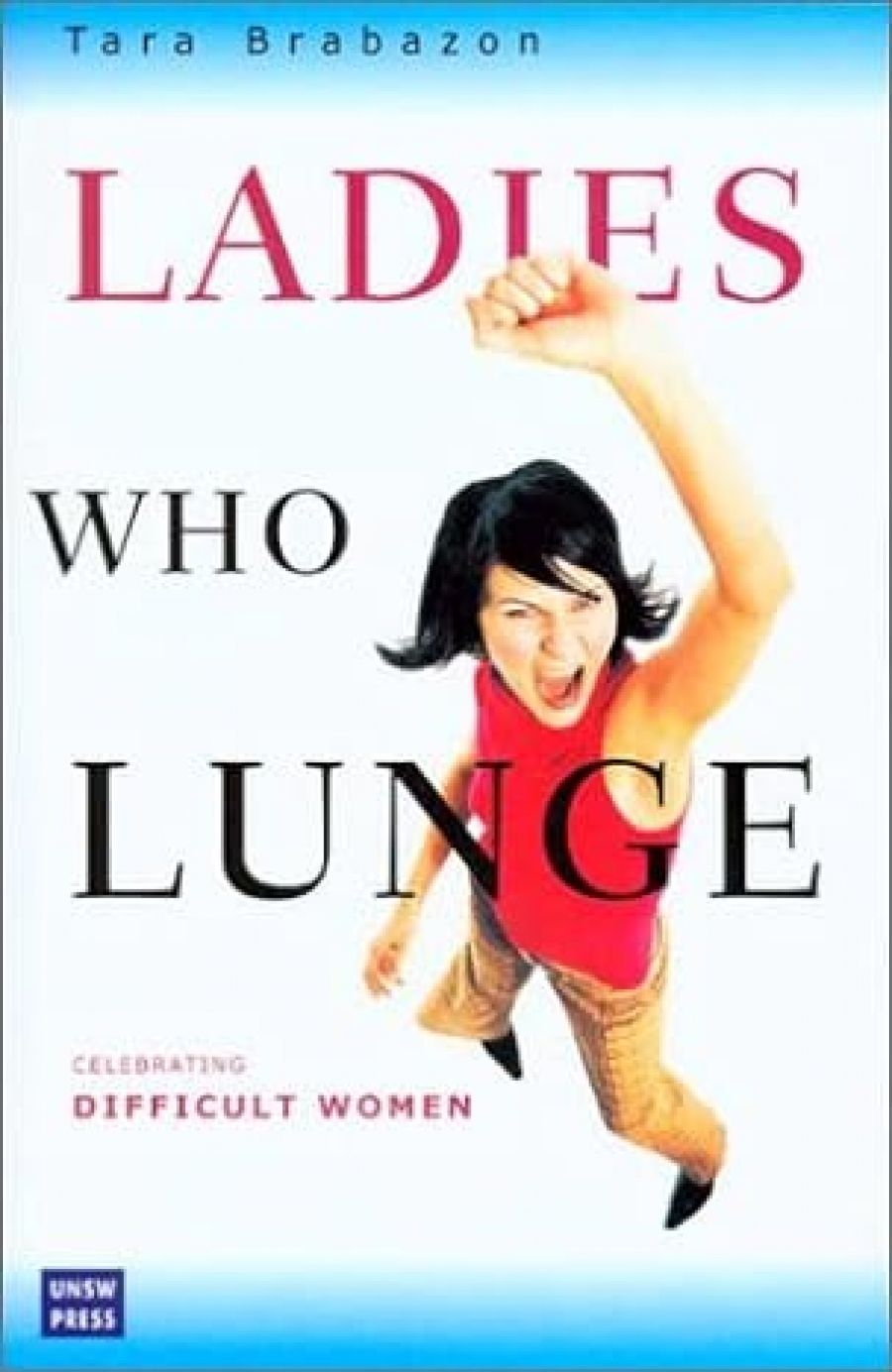
- Free Article: No
- Contents Category: Essay Collection
- Review Article: Yes
- Article Title: Scabs in the Cloth
- Online Only: No
- Custom Highlight Text:
Tara Brabazon’s Ladies Who Lunge: Celebrating Difficult Women is a collection of essays on feminism and popular culture. Addressing a range of subjects – including aerobics, wrestling, Miss Moneypenny, Anita Roddick and the pedagogy of Sylvia Ashton Warner – Brabazon’s material on the whole does justice to her general contention that feminist readings of popular culture need to be fearless and bold. Arguing that feminism requires a (metaphoric) equivalent of the movie Fight Club, Brabazon suggests that feminist critique is at its sharpest when it reads against the grain of mainstream thinking. For the most part, these essays do just that. However, for a book that celebrates the brazenness of feminism, why not include the F word in the title? In fact, the lameness of the title’s pun turns out to be characteristic of a deeper identity crisis. While Brabazon argues for a non-populist feminism, a tough and gritty brave new world of feminist critique, the style and packaging, and sometimes the substance, of her book seem to be trying hard to reach a market that is both ‘young’ and ‘popular’. Not that there is anything intrinsically wrong with this market, but it contradicts Brabazon’s wider project of taking us somewhere other than feminist readings of popular culture that dumb down many of feminism’s most critical insights.
- Book 1 Title: Ladies Who Lunge
- Book 1 Subtitle: Celebrating difficult women
- Book 1 Biblio: UNSW Press, $29.95 pb, 202 pp, 0 86840 421 7
- Book 1 Cover Small (400 x 600):

- Book 1 Cover (800 x 1200):

Which is a shame, because there is a lot that is clever and punchy about Ladies Who Lunge. I found Brabazon particularly interesting in her discussions of aerobics and wrestling. Rather than align women’s obsession with aerobics with anorexia and other oppressive forms of bodily control, Brabazon provides a subtle reading of this phenomenon in terms of community, gender, sport and feminism. In examining the world of professional wrestling, Brabazon is equally cogent: ‘Wrestling can appear highly conservative. Yet it is also transgressive and provides innovative, hybrid ways of reading male and female bodies. While being a sport, with the accompanying masculine modality, it uses the generic structure of soap opera, a feminine form.’ Carefully researched and often overlaid with thick description of her subject, many of the essays do justice to Brabazon’s argument for the importance of popular culture to feminism and vice versa.
On feminism’s thornier subjects, such as pornography and the media, Brabazon is less forthcoming. Although she has some important things to say about feminism and the media, this material is not developed enough to do it justice. Again, disappointing, because I found her brief comments on the subject apt and timely: ‘While [Catharine Lumby’s] research into media feminism has been enormously important in Australian cultural studies, it is the political equivalent of the bald man’s comb-over. It makes the wearer feel better, but others see through the ruse. No one is ignoring the politics of popular culture. We simply cannot agree on the nature and effectiveness of that politics.’
Perhaps in contrast to Lumby, Brabazon understands the value of studying popular culture, yet avoids the evangelism that has paradoxically seen popular culture come to occupy a privileged position in academic cultural studies. Her ability to temper her discussion with these kinds of subtle distinctions belies her overall tendency for ad hoc conclusions. On the weighty subject of feminism and pornography, Brabazon is unproductively dismissive: ‘I am not remotely interested in pornography. Politically, I am anti-censorship, but am not unilaterally in favour of letting it all hang out, baby.’
Similarly, while Brabazon decries ‘dishcloth-wet writing’ and ‘essential-oil euphemisms’, there are too many moments when her prose is just that. Framing the individual essays are personal anecdotes that sit awkwardly with the other material. In her conclusion, for example, Brabazon reflects on her mother’s tearful and belated realisation of how marriage had resulted in the loss of identity, only to conclude: ‘These micro tears in the fabric of language result in long-term scabs in the cloth of identity?’ This is an unfortunate turn of phrase, which wouldn’t be so bad if Brabazon wasn’t so insistent on refashioning the ‘drab, frumpy language of the academy’.
While there is certainly an argument for academic writing to be clear and engaging for a wide audience, the problem with much of the writing in Ladies Who Lunge is that it falls back on cliché and pop-culture lingo. This tends to clutter ideas rather than make them funky and accessible. I have no problem with the insertion of personal anecdote into formal writing, but here poignant accounts of the personal are often weighed down by clunky academic jargon. What makes ficto-critical writing so powerful is its ability to fuse complex intellectual ideas with the prosaic intimacy of personal experience in a language that does justice to both. Sadly, Brabazon too often does justice to neither.
When Brabazon’s prose is clear and straightforward, her ideas challenge and captivate. In the end, however, I felt that Ladies Who Lunge couldn’t quite decide what it wanted to be: a collection of academic essays or a stream of personal anecdote about feminism, popular culture and the trials of being a single woman. Judicious editing, and less marketing and packaging hype, would have given her bold arguments greater clarity. After all, what is refreshing about this book is that it works with the complexities and contradictions of feminism, showing that, while feminism is sometimes troubled, it maintains its ability to trouble.


Comments powered by CComment